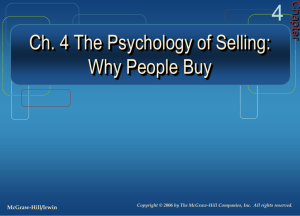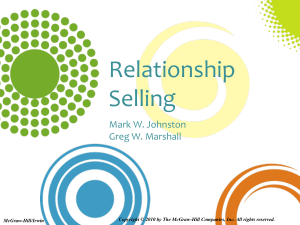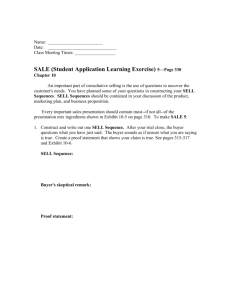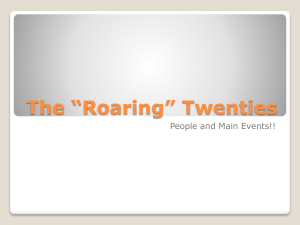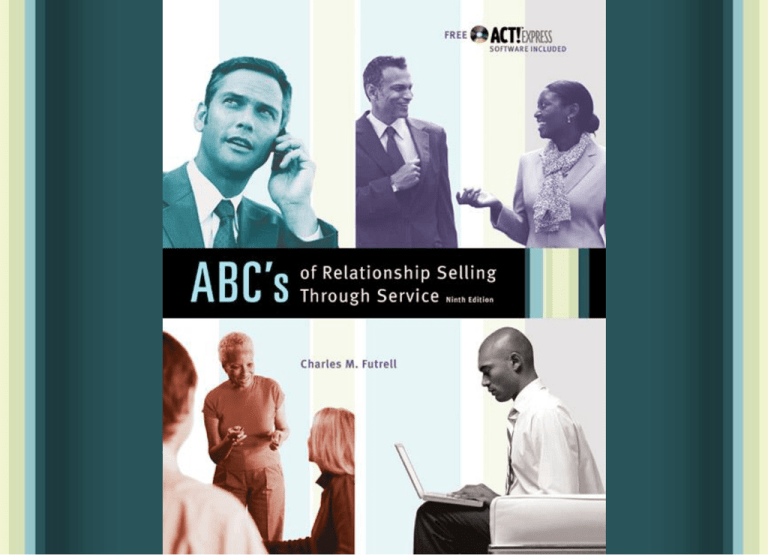
The Psychology of Selling: Why
People Buy
McGraw-Hill/Irwin
3-2
Copyright © 2007 by The McGraw-Hill Companies, Inc. All rights reserved.
Chapter
3
3-3
Chapter
3
Main Topics
3-4
The Tree of Business Life: Benefits
Why People Buy–The Black Box Approach
Psychological Influences on Buying
A FABulous Approach to Buyer Need Satisfaction
How to Determine Important Buying Needs–a Key to
Success
Chapter
3
Main Topics
The Trial Close–a Great Way to Uncover Needs and
3-5
SELL
SELL Sequence
Your Buyer’s Perception
Perceptions, Attitudes, and Beliefs
The Buyer’s Personality Should Be Considered
Adaptive Selling Based on Buyer’s Style
Chapter
3
Main Topics
3-6
You Can Classify Buying Situations
Technology Provides Information
View Buyers as Decision Makers
Satisfied Customers Are Easier to Sell to
To Buy or Not To Buy–a Choice Decision
Chapter
3
The Tree of Business Life: Benefits
T
T T
T T TT
T T T T
Builds
Relationships
3-7
Guided by The Golden
Rule, emphasize benefits
to improve your:
Communication Skills
Ability to unselfishly help a person
make the correct buying decision
Exhibit 3-1: Stimulus-Response Model of
Buyer Behavior
Internalization process is referred to as a
black box
We cannot see into the buyer’s mind.
Stimulus-response model
Sales Presentation
Buyer’s Hidden
Mental Process
Sale/No Sale
Stimulus
Black box
Response
Exhibit 3-1: Stimulus-response model of buyer behavior
3-8
What’s Known About Mental Process
People buy for practical and emotional
reasons.
Some of a person’s thoughts can be
determined.
Buyers consider certain factors in making
purchase decisions.
3-9
Psychological Influences on Buying
Motivation to buy must be there
Needs result from a lack of something desirable
Wants are needs learned by the person
Economic needs: The best value for the
money
The buyer’s need to purchase the most satisfying
product for the money
3-10
Psychological Influences on Buying, cont…
Awareness of needs: Some buyers are unsure
Conscious need level
Preconscious need level
Unconscious need level
3-11
A FABulous Approach to Buyer
Need Satisfaction
Stressing benefits is a very
powerful selling technique
FAB selling technique helps
emphasize benefit
Feature
A dvantage
B enefit
3-12
The Product’s Features: So What?
Feature – a physical characteristic
Many salespeople emphasize features
Examples:
Size
Color
Price
Shape
3-13
The Product’s Advantages: Prove It!
Advantage – a performance characteristic
The chances of making a sale are increased
by describing the product’s advantages.
How a product can be used
How a product will help the buyer
Examples:
Fastest-selling
Stores more information
Copies on both sides of the paper
3-14
The Product’s Benefits: What’s in it for Me?
Benefit – a result of advantage
People are interested in what the product will
do for them.
Benefits can be both practical and
psychological.
Benefits should be specific statements, not
generalizations.
Emphasizing benefits increases sales.
3-15
Why Does Someone Buy These Items?
Diamond ring
Camera film
STP motor oil
Baseball tickets
3-16
People Buy the Product’s Benefits, Such
as:
Diamond ring – images of success,
investment, to please a loved one
Camera film – memories of places, friends,
and family
STP motor oil – engine protection, car
investment, or peace of mind
Baseball tickets – entertainment, escape from
reality, or relaxation
3-17
People Buy Benefits
Not a product’s features
Not a product’s advantages
3-18
People Buy Benefits, cont…
Notice national television commercials
They stress benefits
Advertisers know this helps sell products
3-19
People Buy Benefits, cont…
High performing salespeople stress benefits.
They know this increases their chances of
making the sale and helping someone
3-20
What’s In It For Me?
Stressing benefits in the sales presentation
answers the prospect’s question, “What’s in it
for me?”
3-21
Cannot Leave Out Features and
Advantages
In the sales presentation, it is also important
to mention features and advantages.
Following is an example of how to stress a
benefit while including a feature and an
advantage.
3-22
Let’s Review FABs
“With this ball, you’ll get an extra 10 to 20
yards on your drives (advantage) helping to
reduce your score (benefit ) because of its
new solid core ( feature).”
3-23
FABs Can Be Awkward at First
New salespeople are frequently not
accustomed to using feature, advantage, and
benefit phrases.
They may seem awkward at first.
3-24
Use Your FABs
Feature – Physical Characteristic
Buyer thinks “So What?”
Advantage – Performance Characteristic
Buyer thinks “Prove It!”
Benefit – Favorable result from advantage
Benefits are what people buy!
You can also have a benefit of a benefit – a
FABB
3-25
Use the FAB Sequence
The standardized FAB Sequence can be
used as follows:
The…(feature)…means you…(advantage)…with
the real benefit to you being…(benefit)….
Note how a benefit is emphasized.
Pick a product and insert a FAB of the
product into the above sequence
Put it in your own words
Try it – it works!
3-26
Let’s Review FABs, cont…
Which of the following is a feature, advantage,
or benefit?
1.
2.
3.
4.
5.
F “Made of pure vinyl”
B “Gives 20% more miles to the gallon”
F “New”
A “Lasts twice as long”
B “Saves, time, work, and money”
3-27
Let’s Review FABs
“Blade changing is quick ( advantage) and
easy (benefit ) with this saw because it has a
push button blade release (feature).”
3-28
Let’s Review FABs, cont…
“The king size (feature) will bring you
additional profits (benefit ) because it is the
fastest growing (advantage ) and a more
economical size (feature).”
3-29
Let’s Review FABs, cont…
“For long wear (advantage ) and savings on
your clothing costs (benefit ), you can’t beat
these slacks. All the seams are double
stitched (feature) and the material is 100%
Dacron (feature).”
3-30
The Salesperson Needs to be a Detective
Given that people make a buying decision
based on whether they believe a product’s
benefits will satisfy their needs, how can you
uncover a buyer’s needs?
3-31
Exhibit 3-4: Match Buyer’s Needs to Product’s Benefits
and Emphasize Them in the Sales Presentation
Important
Seller
Important
Needs
Benefits
Unimportant
3-32
(emphasize)
(de-emphasize)
Unimportant
Buyer
How to Determine Important Buying
Needs–A Key to Success
L-O-C-A-T-E
Listen
Observe
Combine
Ask questions
T alk to others
Empathize
3-33
The Trial Close–a Great Way to Uncover
Needs and Sell
The trial close asks for an opinion, not a
decision to buy.
It gives feedback.
The trial close is one of the best
communication techniques in the sales
presentation.
3-34
The Trial Close Helps You to Determine:
Whether the prospect likes your product’s
features, advantages, or benefits
Whether you have successfully answered any
objections
Whether any objections remain
Whether the prospect is ready for you to close
the sale
3-35
In These Examples of Trial Closes, Notice They
Do NOT Ask Someone to Buy Directly
“How does that sound to you?”
“Is this important to you?”
“That’s great – isn’t it?”
“I notice your smile. What do you think
about…?”
3-36
Do You See How the Trial Close Asks for the Person’s
Opinion Concerning What Has Just Been Said?
For example:
“Does that answer your concern?”
“Am I on the right track with this
proposal?”
3-37
The Trial Close Does Not Ask for a
Decision
It asks a question to better understand what
the person is thinking about what is being said
by the salesperson – you
3-38
To Help You Properly Use the FAB Selling
Technique and the Trial Close
Incorporate the SELL Sequence into your
presentation.
3-39
SELL Sequence
SELL Sequence
S - Show Feature - physical characteristic
E - Explain advantage - performance characteristic
L - Lead into benefit - result of advantage
L - Let customer talk - ask opinion question
3-40
Exhibit 3-5: The SELL Sequence: Use It
Throughout Your Presentation
S
E
L
L
Show Explain
Lead
Let
feature advantage into benefit customer talk
3-41
Let’s Review FABs, cont…
“This equipment is made of stainless steel
(feature), which means it won’t rust
(advantage). The real benefit is that it
reduces your replacement costs, thus saving
you money (benefit )! That’s what you’re
interested in – right ( trial close )?”
Skip video
3-42
To pause the video, click on the video screen. To resume
play, click on the video screen again. Click outside the
video screen twice to advance to the next slide.
The Trial Close Is a Powerful
Communication Technique To Produce*
Two-way communication
Participation from the other person
3-44
A Challenge! Use the Trial Close in Your
Normal Conversation To:*
See if it helps your communication
See if it gets the other person to participate in
the conversation
All you do is occasionally ask the person an
opinion type question such as:
“Is that a good place to eat?”
“What did you think about the movie?”
“How does that sound to you?”
3-45
Let’s Review! When Are the Times to Use a
Trial Close?*
1. After making a strong selling point in the
presentation (FABs)
2. After the presentation but before the close
3. After answering an objection
4. Immediately before you move to close the
sale
3-46
Let’s Review! What Does the Trial Close
Allow You to Determine?
1. Whether the prospect likes your product’s
FAB – the strong selling point
2. Whether you have successfully answered
the objection
3. Whether any objections remain
4. Whether the prospect is ready for you to
close the sale
3-47
It Helps to Construct Four Columns when
Creating Your SELL Sequence, Exhibit 3-6
Features
(physical characteristics)
Advantages
(performance characteristics)
Benefits
(result from advantage)
Trial Closes
(feedback questions)
1. Nationally advertised
consumer product
1. Will sell more product
1. Will make you a high
profit
1. What do you think?
2. Air conditioner with a high 2. Uses less electricity
energy-efficiency rating
2. Saves 10 percent in energy 2. Is that important to you?
costs
3. Product made of stainless
steel
3. Will not rust
3. Reduces your replacement 3. How does that sound to
costs
you?
4. Supermarket computer
system with IBM 3651
Store Controller
4. Can store more
information and retrieve it
rapidly by supervising up
to 24 grocery check-out
scanners and terminals
and look up prices on up
to 22,000 items
4. Provides greater accuracy, 4. That’s great–isn’t it?
register balancing, store
ordering, and inventory
management
5. Five percent interest on
money in bank checking
NOW account
5. Earns interest that would
not normally be received
5. Gives you one extra bag of 5. Do you want to earn
groceries each month
extra money?
6. Golf club head made of
aerodynamically designed
titanium steel
6. Increased club head speed,
longer drives
6. Lower scores
3-48
6. And that’s what counts–
right?
Your Buyer’s Perception
Perception – how selects, organizes,
interprets information
Selective exposure – only portion of
information used
Selective distortion – perceptual process
may alter information
Selective retention – may remember only
what supports their attitudes and beliefs
3-49
Perceptions, Attitudes, and Beliefs
Perceptions are learned.
Learning – knowledge based on past
Attitude – learned predispositions
Belief – trust or confidence placed in
something/someone
3-50
The Buyer’s Personality Should Be
Considered
Personality can be viewed as the individual’s
distinguishing character traits, attitudes, or
habits.
Self-concept
Real self
Self-image
Ideal self
Looking-glass self
3-51
Adaptive Selling Based on Buyer’s Style
Personality typing
Adapt your presentation to the buyer’s
style
Thinker style
Intuitor style
Feeler style
Sensor style
3-52
Exhibit 3-8: Guidelines to Identifying
Personality Style
3-53
Exhibit 3-9: Watch for Clues to Someone’s
Personality Type
How would you describe this person?
What is her time orientation – past, present,
future?
What does her desk look
like?
What does her room
look like?
How does she dress?
3-54
Determining Style Can Be Difficult
What is the person’s primary style?
What is the person’s secondary style?
Does the person’s style comprise all four
types?
3-55
First Know Your Style
This helps you to adapt to the other person’s
style
Which leads to better communication
Knowing your style helps you identify a
person’s style, especially if your styles are the
same (It takes one to know one).
3-56
You Can Classify Buying Situations
Some decisions are routine
Some decisions are limited
Some decisions are extensive
3-57
Exhibit 3-10: The Three Classes of Buying
Situations
3-58
Technology Provides Information
Technology provides information for customer
decision making and service.
3-59
View Buyers as Decision-Makers
Five basic steps in the buying decision:
1.Need arousal
2.Collection of information
3.Information evaluation
4.Purchase decision
5.Postpurchase:
Satisfaction
Dissonance
3-60
Exhibit 3-12: Personal, Psychological, and Social
Forces that Influence Consumers’ Buying Behavior
Consumer buying decision process
3-61
Satisfied Customers Are Easier to Sell To
It is easier to sell to a customer than to a
stranger.
Building a relationship is important to a
salesperson’s success.
3-62
To Buy or Not to Buy–a Choice Decision
A salesperson needs to understand:
Factors that can influence the buying decision
That buyers actually examine various factors that
influence these decisions
That buyers actually go through various steps in
making decisions
3-63
Summary of Major Selling Issues
As a salesperson, be knowledgeable.
Understand the characteristics of the target
market and how these characteristics relate to
the buyer’s behavior.
The individual goes through various steps in the
three buying situations of routine decision
making, limited decision making, and extensive
decision making.
Uncover who is involved in the buying decision
and the main factors that influence the decision.
3-64
Summary of Major Selling Issues, cont…
Psychological factors include the buyer’s motives,
perceptions, learning, attitudes, beliefs, and
personality.
Not all prospects will buy your products due to the
many factors influencing their buying decision.
You will need to uncover buyer’s needs, solve
buyer’s problems, and provide the knowledge that
allows them to develop personal attitudes toward
the product.
3-65
End of Chapter 3
McGraw-Hill/Irwin
3-66
Copyright © 2007 by The McGraw-Hill Companies, Inc. All rights reserved.
Chapter
3

